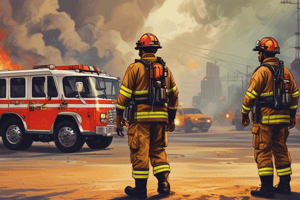Podcast
Questions and Answers
What are some administrative duties of a Fire Officer II as mentioned in the text?
What are some administrative duties of a Fire Officer II as mentioned in the text?
- Supervising tactical priorities
- Completing news releases
- Conducting emergency response activities
- Developing project budgets (correct)
What distinguishes a Fire Officer II from a Fire Officer I according to the text?
What distinguishes a Fire Officer II from a Fire Officer I according to the text?
- Managing a multiunit station (correct)
- Completing employee performance appraisals
- Performing emergency activities
- Evaluating subordinates' job performance
What is the purpose of delegating rulemaking power to an administrative agency under the Model State Administrative Procedure Act (MSPA)?
What is the purpose of delegating rulemaking power to an administrative agency under the Model State Administrative Procedure Act (MSPA)?
- Reducing transparency in rulemaking
- Limiting administrative control
- Bringing scientific and technical expertise into rule creation (correct)
- Enhancing legislative authority
What are State Police Powers as described in the text?
What are State Police Powers as described in the text?
Why did the legislature delegate the rulemaking power to an administrative agency according to the text?
Why did the legislature delegate the rulemaking power to an administrative agency according to the text?
Based on the text, how does the incident commander assign resources when tasks outnumber available resources?
Based on the text, how does the incident commander assign resources when tasks outnumber available resources?
What is the second most common reason for fire service response according to the text?
What is the second most common reason for fire service response according to the text?
According to NFIRS data, what percentage of fire company response workload does firefighting account for?
According to NFIRS data, what percentage of fire company response workload does firefighting account for?
In how many percent of activated alarm responses is there an actual fire?
In how many percent of activated alarm responses is there an actual fire?
What is one of the primary causes of noncardiac death to firefighters operating in a burning structure according to the text?
What is one of the primary causes of noncardiac death to firefighters operating in a burning structure according to the text?
Which term refers to looking beyond physical attributes and matching individual strengths with organizational needs?
Which term refers to looking beyond physical attributes and matching individual strengths with organizational needs?
What was established as the primary effect of the Norris-LaGuardia Act?
What was established as the primary effect of the Norris-LaGuardia Act?
What did the Norris-LaGuardia Act of 1932 establish according to the text?
What did the Norris-LaGuardia Act of 1932 establish according to the text?
Which term describes the process where employees negotiate with employers through their unions to determine employment terms?
Which term describes the process where employees negotiate with employers through their unions to determine employment terms?
What was the term used when an employer required an employee not to join a union?
What was the term used when an employer required an employee not to join a union?
Which piece of legislation established the groundwork for the present collective bargaining system according to the text?
Which piece of legislation established the groundwork for the present collective bargaining system according to the text?
What is the main focus of Fire Officer I and II levels according to the text?
What is the main focus of Fire Officer I and II levels according to the text?
Which responsibility is unique to a Fire Officer II compared to a Fire Officer I?
Which responsibility is unique to a Fire Officer II compared to a Fire Officer I?
What duty does the International Association of Fire Chiefs assign to a Fire Officer II?
What duty does the International Association of Fire Chiefs assign to a Fire Officer II?
Which term best describes what collective bargaining involves?
Which term best describes what collective bargaining involves?
What does the Norris-LaGuardia Act of 1932 aim to prevent?
What does the Norris-LaGuardia Act of 1932 aim to prevent?
What is the primary cause of noncardiac death within a burning structure according to the text?
What is the primary cause of noncardiac death within a burning structure according to the text?
What is the second most common reason for fire service response as per the text?
What is the second most common reason for fire service response as per the text?
'Yellow dog contracts' were eliminated following the enactment of which legislation?
'Yellow dog contracts' were eliminated following the enactment of which legislation?
'Positive-pressure ventilation' is typically a task assigned to what type of firefighting personnel?
'Positive-pressure ventilation' is typically a task assigned to what type of firefighting personnel?
'Natural ventilation' in firefighting refers to what specific action?
'Natural ventilation' in firefighting refers to what specific action?
What is one area that many fire departments struggle with according to the text?
What is one area that many fire departments struggle with according to the text?
What is a primary duty of a Fire Officer II with respect to professional development plans?
What is a primary duty of a Fire Officer II with respect to professional development plans?
Flashcards are hidden until you start studying
Study Notes
Fire Officer Roles and Responsibilities
- A Fire Officer II has administrative duties, including developing professional development plans, allocating resources, and assigning tasks.
- A Fire Officer II differs from a Fire Officer I in that the II has more responsibilities, including resource allocation and task assignment.
Administrative Law and Collective Bargaining
- The Model State Administrative Procedure Act (MSPA) delegates rulemaking power to administrative agencies to ensure efficiency and expertise.
- State Police Powers refer to the authority of states to regulate and enforce laws for the health, safety, and welfare of citizens.
- The legislature delegates rulemaking power to administrative agencies to tap into their expertise and ensure effective implementation of laws.
Incident Command and Resource Allocation
- When tasks outnumber available resources, the incident commander assigns resources based on priority and allocates them effectively.
Fire Service Response and NFIRS Data
- The second most common reason for fire service response is medical calls.
- According to NFIRS data, firefighting accounts for only 3.5% of fire company response workload.
- In 93.5% of activated alarm responses, there is no actual fire.
Firefighter Safety and Health
- One of the primary causes of noncardiac death to firefighters operating in a burning structure is cardiac arrest due to overexertion.
Human Resources and Collective Bargaining
- The term "job matching" refers to looking beyond physical attributes and matching individual strengths with organizational needs.
- The Norris-LaGuardia Act of 1932 aimed to prevent "yellow dog contracts" and established the groundwork for the present collective bargaining system.
- Collective bargaining involves negotiation between employees and employers through unions to determine employment terms.
Fire Officer I and II Responsibilities
- The main focus of Fire Officer I and II levels is on tactical operations and strategic management.
- A Fire Officer II has the unique responsibility of developing professional development plans and allocating resources.
Miscellaneous
- The International Association of Fire Chiefs assigns a Fire Officer II to oversee training and operations.
- Many fire departments struggle with resource allocation and task assignment.
- Positive-pressure ventilation is typically a task assigned to engine company personnel.
- Natural ventilation in firefighting refers to the act of opening doors and windows to allow smoke and heat to escape.
Studying That Suits You
Use AI to generate personalized quizzes and flashcards to suit your learning preferences.




